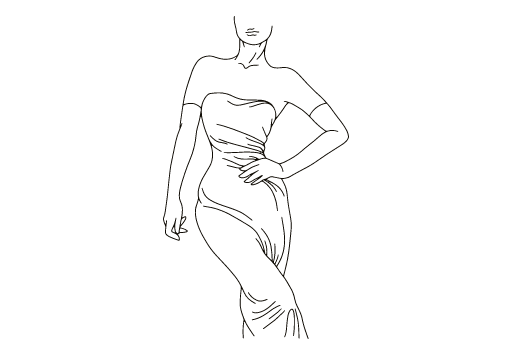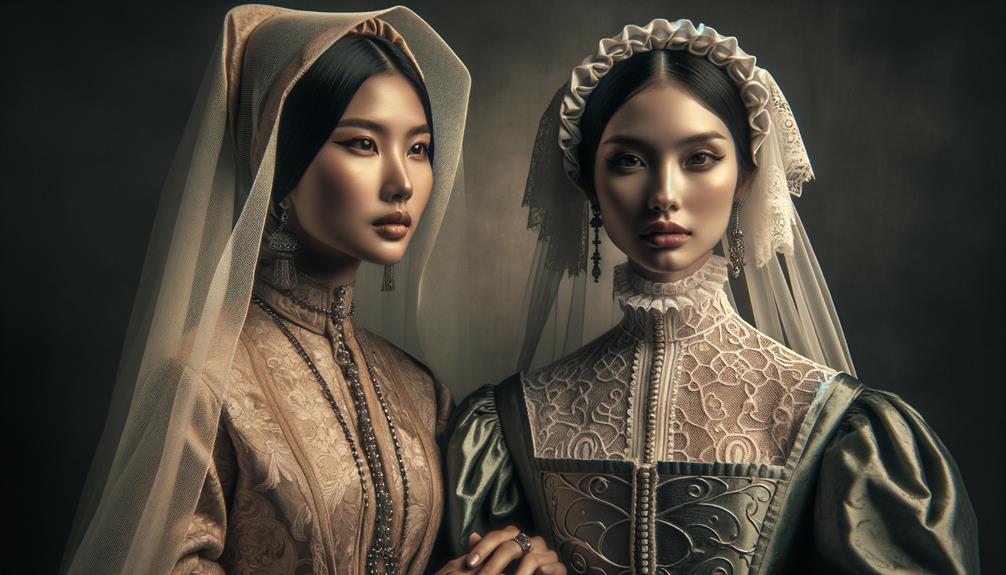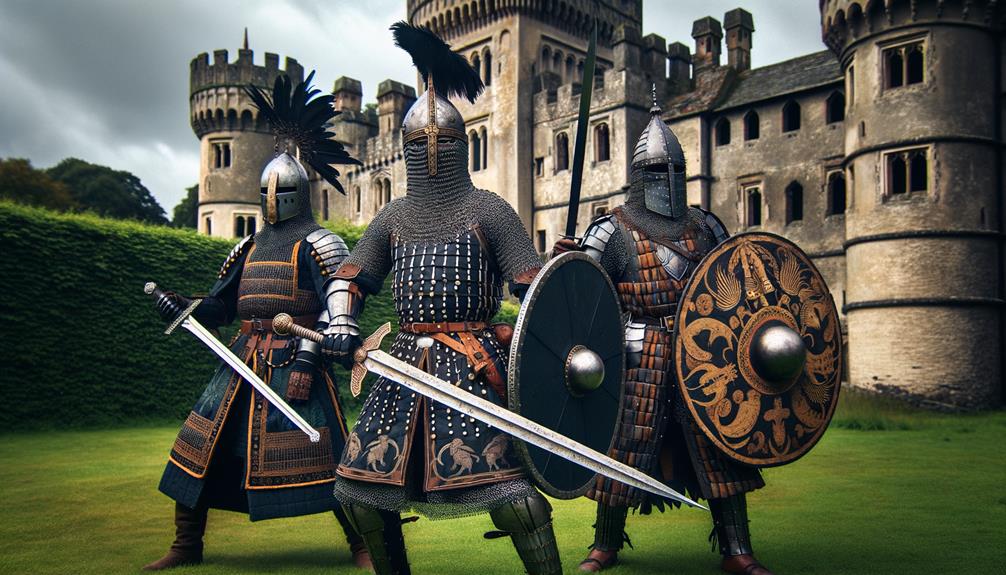Heraldic symbols might seem like a quaint medieval relic, but their influence on fashion is actually quite captivating. I've noticed how these intricate designs woven into garments were more than just decorations – they were a sophisticated language of lineage and identity. Each element, from colors to animals, told a story of heritage and status, transforming clothing into a canvas of personal and familial pride. It's intriguing to think about how these visual codes communicated so much about an individual's place in society. What deeper meanings and subtleties did these symbols truly convey?
Origins of Heraldic Symbols
Exploring the origins of heraldic symbols, I find it fascinating that these intricate designs began as practical identifiers for knights on medieval battlefields. In the chaos of combat, recognizing friend from foe was crucial. Knights, clad in armor, needed a way to distinguish themselves, and thus heraldic symbols were born. Painted on shields and banners, these symbols transformed into unique markers of identity.
What intrigues me most is how these symbols evolved beyond the battlefield to represent medieval royal lineage and prestige. Families adopted these emblems to showcase their heritage, with each element meticulously chosen to convey specific virtues. The language of heraldry itself reflects this evolution, with terms defining each component.
As I delve deeper, I see that these symbols weren't just decorative. They were coded messages, with lions, eagles, and dragons symbolizing courage and power, while crosses and stars stood for faith and honor. This system provided a visual lexicon that communicated a family's values and status.
Understanding the origins of heraldic symbols offers a unique perspective on medieval society, where innovation met tradition, and identity was painted in vivid, symbolic strokes.
Symbolism and Meaning
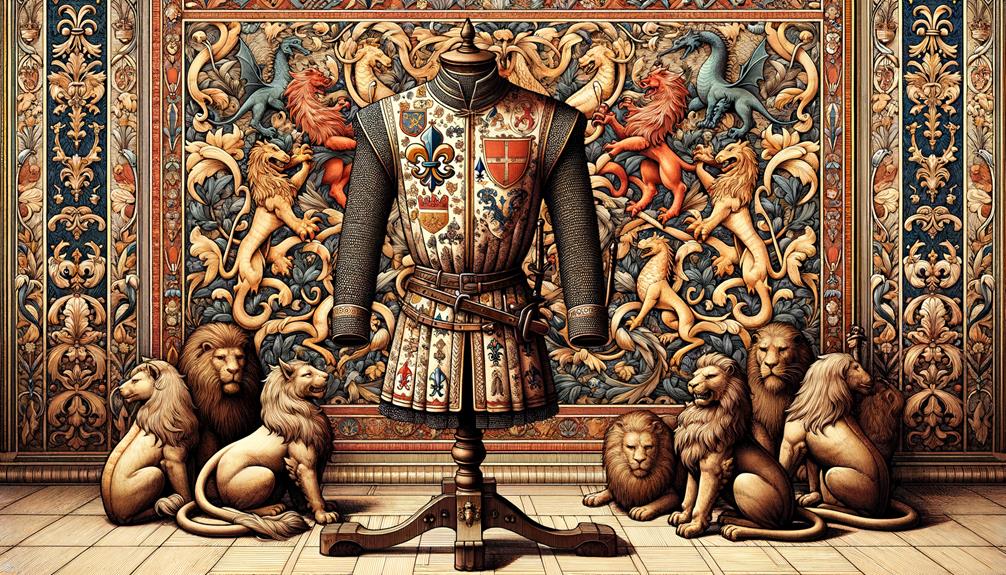
As I delve into the world of medieval heraldry, I'm struck by the significance of colors and common animals. Each hue and creature was chosen with care, reflecting personal and familial values. I imagine knights and nobles adorned with lions, symbolizing courage, or eagles, representing nobility. The profound messages encoded in their attire resonate deeply.
Colors and Their Significance
When we delve into the vibrant world of medieval heraldry, it's fascinating to explore how each color tells its own unique story of symbolism and meaning. Take, for instance, a red shield. In the world of heraldry, red boldly proclaims courage and valor. This color doesn't just stand out visually; it also speaks to bravery and fierce determination, qualities that warriors and nobles aimed to embody.
Blue, on the other hand, conveys loyalty and truth. This hue speaks to steadfastness and reliability, essential traits in a world where allegiance was often a matter of life and death. Green evokes sentiments of hope and joy, painting a picture of renewal and growth amidst the often tumultuous medieval landscape.
Black, with its somber notes, symbolizes constancy and grief, reflecting a steadfast, enduring nature, even in times of sorrow. Purple, the color of royalty and power, was reserved for the highest echelons of society, denoting prestige and sovereignty.
Gold, or 'Or,' signifies generosity and a lofty mind, while silver, or 'Argent,' embodies peace and sincerity. Together, these colors create a rich, layered narrative that speaks volumes about the values and ideals of medieval society.
Common Heraldic Animals
Exploring heraldic animals, I'm drawn to the lion, which embodies strength, courage, and royal nobility. This regal beast frequently dominates coats of arms, serving as a vivid reminder of the noble virtues it represents. When I see a lion on a shield, I see more than just an animal; I see the epitome of bravery and leadership that medieval knights aspired to.
The eagle is another captivating symbol, representing power and leadership. Its presence on coats of arms exudes dignity and authority. With their keen vision and commanding flight, eagles embody the aspiration to rise above and lead with wisdom and grace.
Dragons, steeped in myth and legend, signify protection, wisdom, and immense power on coats of arms. Their mythical allure adds a layer of mystique and strength, suggesting a guardian spirit that watches over and defends.
In contrast, crosses on heraldic shields reflect faith and spirituality, grounding the wearer in their religious devotion. Stars, on the other hand, symbolize honor and ambition, highlighting achievements and inspiring greatness, pointing to a future filled with promise and aspiration.
Heraldic Colors and Their Significance
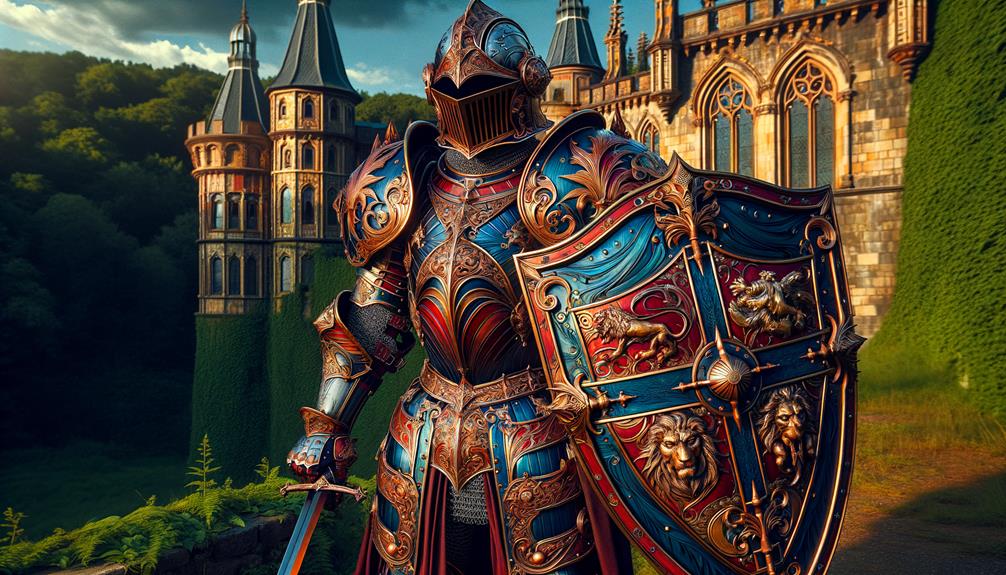
I've always been fascinated by the choice of colors in heraldry, each with its distinct significance. For instance, combining red, which symbolizes strength, with blue, which represents loyalty, sends a powerful message about a person's courage and trustworthiness. When I see these colors come together on shields and garments, I appreciate the careful thought that goes into selecting every hue and pairing.
Symbolism of Colors
In the medieval world of heraldry, colors weren't just for show; they carried profound meanings that reflected the values and aspirations of the time. Each shade on a coat of arms wasn't merely decorative but a deliberate choice to communicate character and ideals. Red, for instance, symbolized courage and strength, a trait prized in knights and leaders. Blue represented loyalty, essential in a world where alliances were crucial. Green signified hope and joy, while black denoted wisdom and constancy. Purple, a color commanding respect, embodied royalty and high rank.
Gold (Or) illustrated generosity and elevation of the mind, whereas silver (Argent) conveyed peace and sincerity. Heraldic furs like ermine and vair added layers of meaning; ermine stood for purity and dignity, while vair signified wealth and prosperity. The choice of colors wasn't random but a thoughtful expression of identity and ambition.
Here's a brief overview of their meanings:
| Color | Symbolism | Meaning |
|---|---|---|
| Red | Valor | Courage and strength |
| Blue | Loyalty | Faithfulness and trust |
| Green | Hope | Joy and renewal |
| Black | Wisdom | Constancy and resolve |
These colors weren't merely about aesthetics; they told a vivid narrative through each coat of arms.
Color Combinations
Here's the rewritten text:
Have you ever stopped to think about how the colors on a coat of arms can reveal a deeper, more intricate story? Each hue is deliberately chosen to convey meaning. For instance, red, symbolizing valor, might be paired with gold to emphasize courageous generosity. Meanwhile, blue, representing loyalty, combined with silver, paints a picture of sincere faithfulness and peace.
In illuminated manuscripts, these color combinations were meticulously selected to ensure the message was clear. Green, signifying hope, might be juxtaposed with the dignity of ermine to highlight a balance between aspiration and respect. Black, denoting constancy, could be paired with vair to symbolize steadfast perseverance through the ages.
Purple's regal sovereignty, when combined with any other color, further elevates the coat of arms' prestige and authority. The use of bright, strong colors ensures that these symbols are not just seen but felt, even from a distance. Proper colors maintain the authenticity of the charges, weaving a rich tapestry of meaning that transcends mere visuals and taps into historical and emotional depths.
Common Heraldic Charges
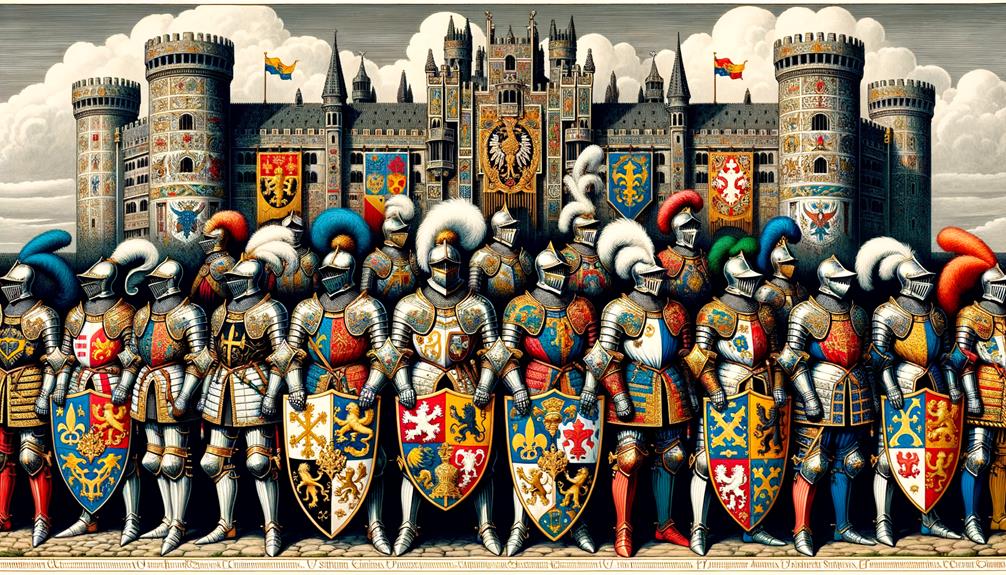
As I delve into the fascinating world of medieval heraldry, I'm struck by the prominence of charges like lions, crosses, eagles, dragons, and stars, each imbued with profound symbolism and significance. These symbols weren't just decorative; they conveyed vital information about the bearer's social status and personal virtues.
The lion, a stalwart of heraldic design, personifies courage, royalty, and strength. It's a bold declaration of one's noble lineage and valor. Crosses, ubiquitous in heraldry, represent faith, piety, and a strong connection to Christianity. Their presence on a coat of arms often indicated a person's devoutness and moral standing.
Eagles, with their majestic wings spread wide, symbolize nobility, dignity, and unparalleled strength. They convey a sense of esteemed status and authority. Dragons, mythical and fierce, are emblematic of wisdom, protection, and formidable strength, often chosen to denote guardianship and sagacity.
Stars, twinkling in the heraldic night sky, signify honor, ambition, and greatness. They are aspirational symbols, reflecting the bearer's lofty goals and distinguished character. Each of these charges not only beautified the heraldic shield but also communicated powerful messages about identity and aspiration.
Animals in Heraldic Design
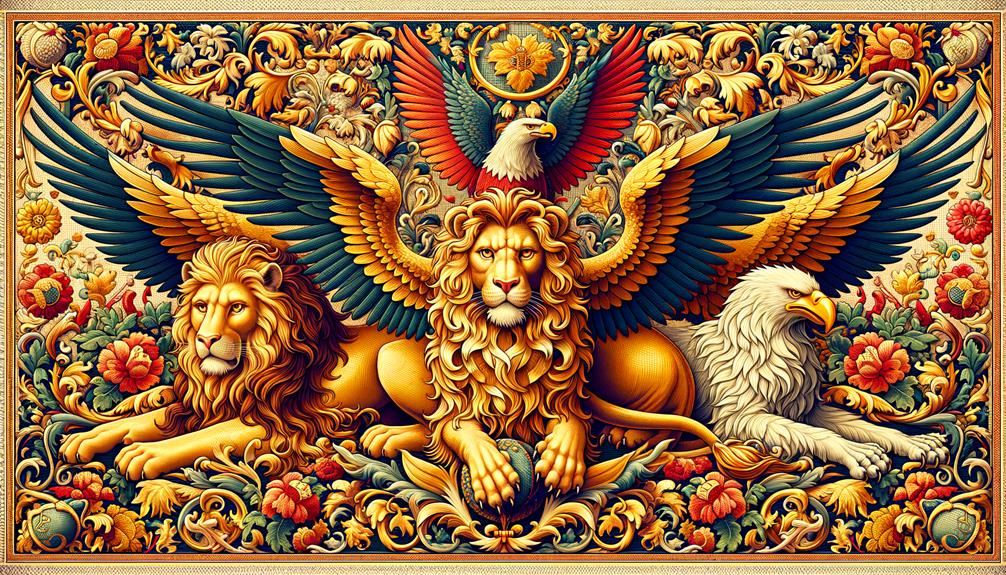
Exploring the fascinating world of animals in heraldic design, I'm struck by how each creature embodies distinct virtues and historical significance. During the Middle Ages, these animals weren't just decorative; they conveyed powerful messages about the bearer's lineage, virtues, and aspirations. Four animals stand out in the rich tapestry of heraldic symbolism:
- Lions: Often representing courage and leadership, lions were a common sight on the shields of royalty. Their imposing presence signified the regal authority and bravery of the bearer.
- Eagles: Symbolizing strength and vision, eagles were frequently used by noble families. The bird's ability to soar high and spot distant prey made it a fitting emblem for those who aspired to power and dominance.
- Horses: These noble creatures stood for loyalty and speed. Knights and warriors often chose horses to signify their readiness for battle and their unwavering loyalty to their sovereign.
- Griffins: Combining the strengths of both lions and eagles, griffins epitomized courage and protection. They were mythical guardians, representing vigilance and the fierce defense of one's territory.
Heraldic Symbols in Clothing
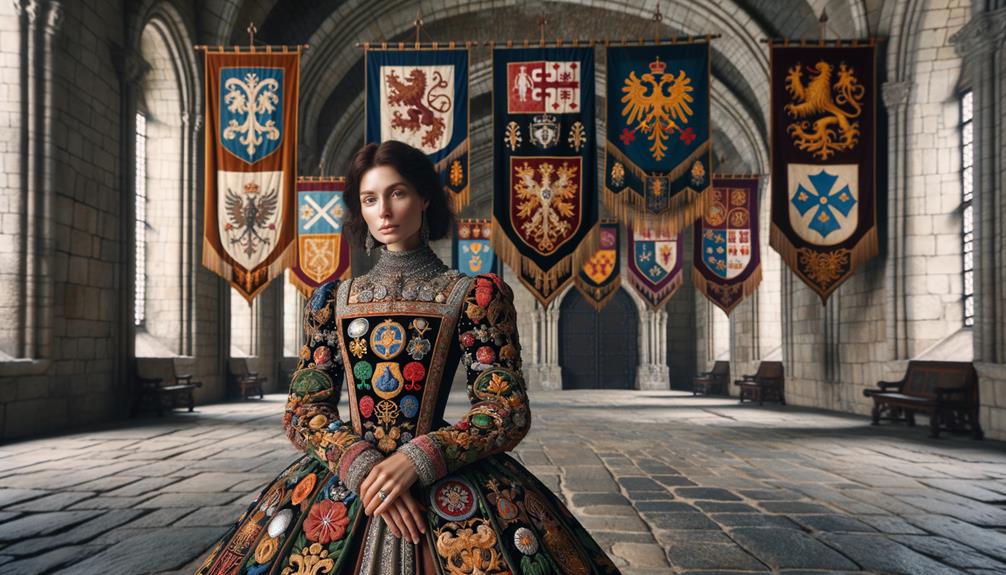
Shifting my focus from the bold animals depicted on shields, I'm drawn to how heraldic symbols intricately adorned the clothing of medieval nobility, telling stories of lineage and status in every stitch. These symbols were more than mere decorations; they wove a narrative of identity and allegiance, sewn directly into the fabric of society.
Noble individuals didn't just wear garments; they wore their heritage. Every coat of arms, meticulously embroidered or woven, transformed a simple piece of clothing into a declaration of noble lineage. The heraldic symbols served as essential markers, allowing others to instantly recognize one's family ties and social standing. It wasn't just the outerwear that carried these symbols – linings, trims, and even accessories were adorned with these powerful emblems, extending their significance to every layer of attire.
In ceremonial events and court functions, the presence of heraldic symbols on clothing was a striking display of wealth and power. The intricate designs communicated not just personal identity, but also one's allegiance to a particular family or kingdom. Truly, these garments were a living, breathing representation of medieval society's intricate social hierarchy.
Frequently Asked Questions
What Is Heraldry in the Middle Ages?
Heraldry in the Middle Ages was a unique system where knights used distinct symbols on their shields to identify themselves on the battlefield. Over time, it evolved to represent a person's lineage, achievements, and social status, becoming deeply intertwined with medieval culture and identity.
What Do the Symbols Mean in the Middle Ages Coat of Arms?
Imagining a lion that could leap over mountains, I see symbols in medieval coats of arms as vibrant stories – lions represent courage, eagles signify nobility, dragons embody protection, crosses symbolize faith, and stars symbolize ambition.
What Is the Heraldic Symbol?
Here's a rewritten version of the text:
I find heraldic symbols fascinating. They're unique emblems that represent a person's lineage, values, or achievements. Each element is carefully crafted to reflect the personal story of the bearer, making them a captivating blend of art and history.
Let me know if this meets your requirements!
What Do the Color Mean in Medieval Heraldry?
I was just thinking about the colors used in medieval heraldry. Red symbolizes bravery, blue represents loyalty, green signifies hope, black is associated with mourning, and purple represents power. It's fascinating how colors held such significant meanings back then.

